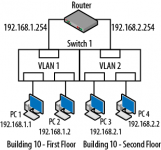Hi All,
Hoping to get some clarification and solution to my network setup. I currently have a Edgerouter X and a UniFi AP. My network consists of three VLANs (Main, IoT, and Guest). The main Lan can access IoT but the IoT can't access the main Lan. The guest VLAN is isolated but has access to the WAN. The Edgerouter handles this well.
I want to replace the Edgerouter with the Asus AC86U running Merlin to take advantage of the AC86U's hardware accelerated VPN features. My research has turned up solutions that use port based VLANs. Since I have one AP that tags devices based on the wifi network it's connected to, I haven't been able to use those solutions. I'm also not using the wifi radios on the AC86U since it will be in the basement and can't provide the necessary coverage to the whole house.
My question is, is it possible for the AC86U to handle tagged VLANs from the UniFi AP? If so, how should I go about setting things up?
If not, is there a way to use the AC86U as a VPN server only?
Thanks in advance.
Hoping to get some clarification and solution to my network setup. I currently have a Edgerouter X and a UniFi AP. My network consists of three VLANs (Main, IoT, and Guest). The main Lan can access IoT but the IoT can't access the main Lan. The guest VLAN is isolated but has access to the WAN. The Edgerouter handles this well.
I want to replace the Edgerouter with the Asus AC86U running Merlin to take advantage of the AC86U's hardware accelerated VPN features. My research has turned up solutions that use port based VLANs. Since I have one AP that tags devices based on the wifi network it's connected to, I haven't been able to use those solutions. I'm also not using the wifi radios on the AC86U since it will be in the basement and can't provide the necessary coverage to the whole house.
My question is, is it possible for the AC86U to handle tagged VLANs from the UniFi AP? If so, how should I go about setting things up?
If not, is there a way to use the AC86U as a VPN server only?
Thanks in advance.



